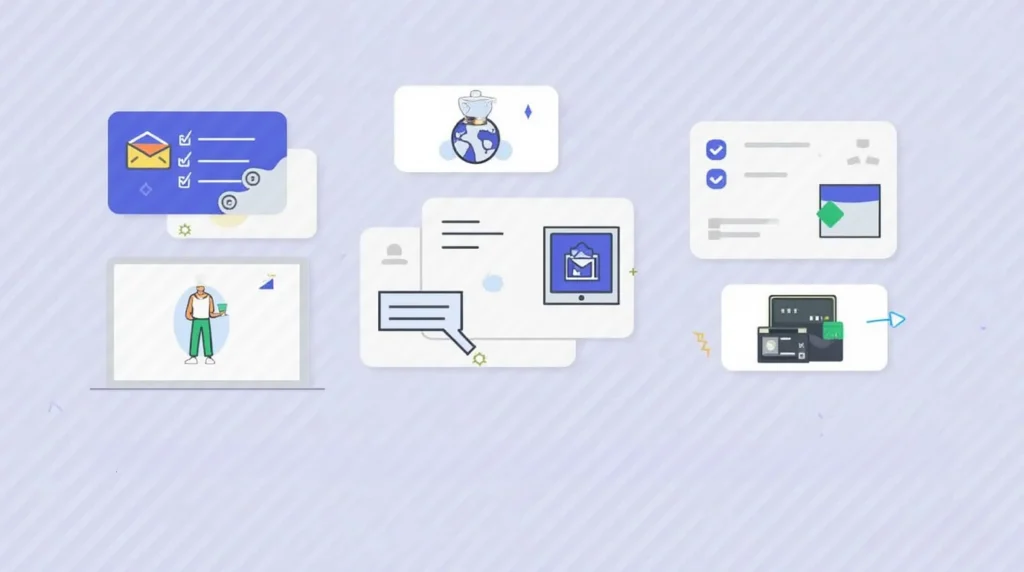Last update - June 9th, 2025
Ever looked at your Google Analytics dashboard and panicked at a 73% bounce rate? You’re not alone!
But here’s the twist: a high bounce rate doesn’t always mean disaster—and obsessing over a single number might actually mislead your strategy. In this guide, we’ll explore proven bounce rate optimization strategies that help you not only reduce exits but also create a better user experience that drives real engagement.
Table of Contents
Bounce rate is one of the most misunderstood metrics in digital marketing. While a high bounce rate can feel alarming—especially when it appears to signal that visitors are leaving your site without taking action—the reality is more nuanced than many marketers realize.
Understanding and implementing effective bounce rate optimization strategies can transform your website’s performance, but only when applied with proper context and methodology. This comprehensive guide explores proven techniques to reduce unnecessary exits and convert passive visitors into engaged users.
What Is Bounce Rate and Why Does It Matter?
Bounce rate represents the percentage of single-page sessions on your website—visits where users enter and exit without interacting further with your site. This metric serves as a critical indicator of user satisfaction and content relevance, though its interpretation requires careful consideration.
A visitor might spend five minutes reading a detailed article and leave fully satisfied without taking additional action. That still counts as a bounce, yet represents a successful user experience. The key lies in understanding when bounce rate optimization strategies should be prioritized versus when high bounce rates are acceptable.
1- When High Bounce Rate Signals Problems
Certain scenarios make high bounce rates a clear red flag requiring immediate attention:
1- Homepage Performance Issues: High bounce rates on homepages often suggest confusion, weak messaging, or poor design that fails to communicate value proposition effectively.
2- E-commerce Product Page Exits: When potential customers leave product pages without exploring further, it typically indicates lost conversion opportunities due to insufficient information, poor presentation, or trust issues.
3- Service Page Underperformance: Service pages that fail to prompt inquiries may lack clarity, relevance, or compelling calls-to-action that guide visitors toward engagement.
4- Multi-step Process Abandonment: Sign-up forms, checkout processes, or other multi-step flows that lose users at the first step indicate significant friction or trust barriers.
In these scenarios, implementing targeted bounce rate optimization strategies can dramatically improve performance and revenue generation.
2- When High Bounce Rate Is Acceptable
Conversely, certain page types naturally exhibit higher bounce rates without indicating poor performance:
1- Informational Blog Content: Blog posts that comprehensively answer user questions may result in satisfied single-page visits.
2- Contact and Reference Pages: These pages often deliver key information immediately, requiring no further site navigation.
3- Single-Action Landing Pages: Pages designed for specific outcomes—downloads, registrations, or newsletter signups—may fulfill their purpose in one interaction.
4- Educational Resources: Reference content, tutorials, or guides may completely satisfy user intent without requiring additional page views.
The goal of bounce rate optimization strategies isn’t achieving an arbitrary low number—it’s improving alignment between content and user intent.
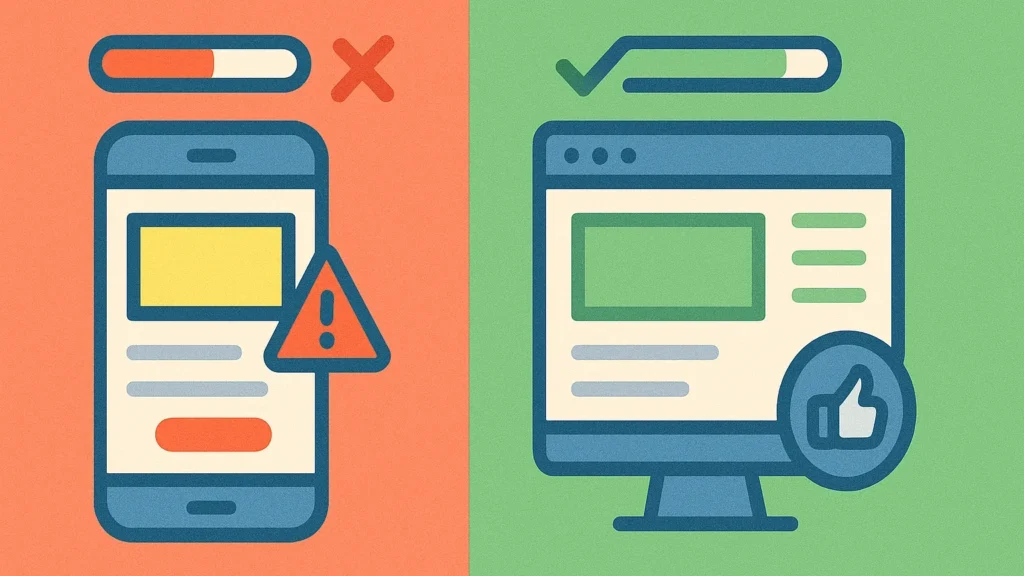
Root Causes of High Bounce Rate
Before implementing bounce rate optimization strategies, identifying underlying issues is essential. Common causes include:
1- Content-Expectation Mismatch
When page titles, meta descriptions, or search snippets over-promise and content under-delivers, users leave immediately. This misalignment between user expectations and actual page content represents one of the most common causes of high bounce rates.
2- Technical Performance Issues
Page loading speed critically impacts user retention. Research consistently shows that pages taking more than three seconds to load lose nearly 40% of visitors before content even appears. Technical performance forms the foundation of all effective bounce rate optimization strategies.
3- Mobile Experience Deficiencies
With mobile traffic exceeding 60% for most websites, poor mobile experiences drive significant bounce rate increases. Non-responsive designs, difficult navigation, or slow mobile loading times push users away before they can engage with content.
4- Weak Call-to-Action Implementation
When users feel uncertain about next steps, they often take no action at all. Every page should provide clear, logical progression paths that guide users toward desired outcomes.
5- Poor Visual Design and Layout
Cluttered layouts, poor visual hierarchy, and overwhelming content blocks discourage users from staying on pages long enough to find value.
6- Technical Errors and Functionality Issues
404 errors, broken links, malfunctioning forms, or other technical problems instantly damage user trust and derail engagement efforts.
Proven Bounce Rate Optimization Strategies
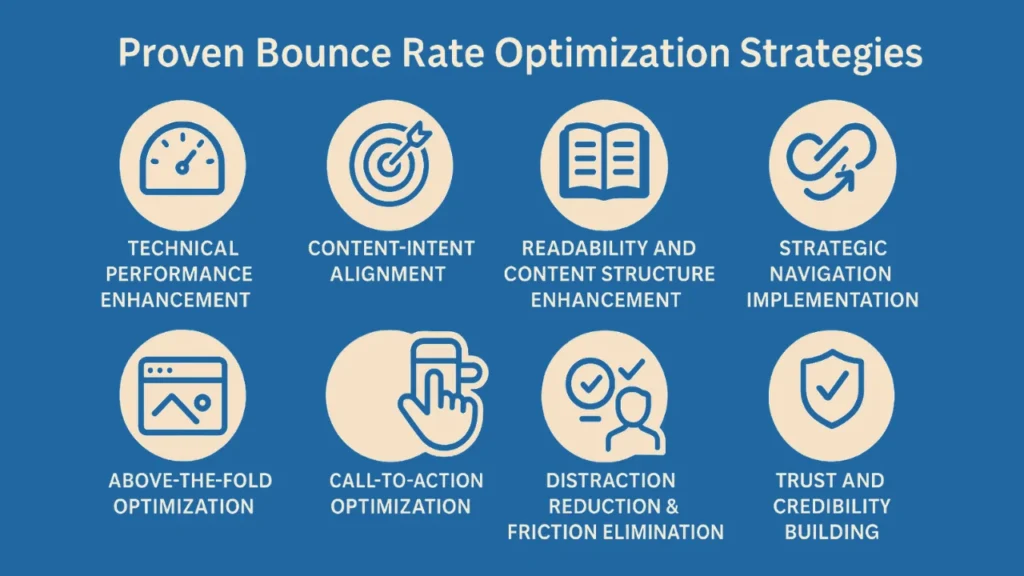
1- Technical Performance Enhancement
Speed and stability form the cornerstone of effective bounce rate optimization strategies. Technical improvements include:
Content Delivery Network Implementation: CDNs distribute content faster across geographic regions, reducing loading times for users regardless of location.
Browser Caching Optimization: Proper caching reduces load times for returning visitors by storing frequently accessed files locally.
Image and Resource Optimization: Compressing images, minifying CSS and JavaScript files, and reducing HTTP requests significantly improve page speed.
Mobile Responsiveness Testing: Regular testing across devices ensures consistent performance and user experience.
Link and Functionality Monitoring: Proactive identification and resolution of broken links, forms, or other technical issues maintains user trust.
These backend improvements ensure users remain on pages long enough to engage meaningfully with content.
2- Content-Intent Alignment
Relevance represents the most powerful element in bounce rate optimization strategies. Effective alignment involves:
Keyword Intent Analysis: Understanding the specific intent behind target keywords allows for content structuring that meets user expectations.
Meta Information Accuracy: Meta titles and descriptions must accurately reflect on-page content to prevent expectation mismatches.
Content Format Matching: Providing how-to guides for instructional queries, product comparisons for buying-intent searches, and comprehensive resources for research-based searches.
Search Result Snippet Optimization: Ensuring that search engine snippets accurately represent page content prevents disappointed visitors.
Well-aligned content reduces friction and improves overall session quality, making this one of the most impactful bounce rate optimization strategies.
3- Readability and Content Structure Enhancement
Visitors scan content before committing to reading. Structural improvements include:
Paragraph Length Optimization: Short paragraphs and descriptive subheadings improve content digestibility.
Visual Content Integration: Strategic use of images, infographics, videos, and charts maintains reader interest and breaks up text-heavy sections.
White Space Utilization: Proper spacing prevents overwhelming layouts and guides attention to key elements.
Tone and Voice Consistency: Maintaining appropriate conversational tone for target audiences improves engagement and reduces cognitive load.
These readability enhancements keep visitors engaged and reduce likelihood of premature exits.
4- Strategic Navigation Implementation
Effective site navigation enables users to explore with confidence. Navigation bounce rate optimization strategies include:
Menu Simplification: Clear, familiar terminology and logical groupings reduce navigation confusion.
Breadcrumb Implementation: Showing page hierarchy and user location within site structure improves orientation.
Internal Search Functionality: Robust search features help users find specific information quickly.
Contextual Internal Linking: Strategic linking to related content using descriptive anchor text encourages deeper site exploration.
Content Hub Development: Organizing related articles and resources into accessible hubs increases session depth.
Strong navigation systems channel users toward deeper interaction and conversion opportunities.
5- Above-the-Fold Optimization
Initial page impressions determine whether users stay or leave immediately. Critical above-the-fold elements include:
Value Proposition Clarity: Headlines must directly address user intent and communicate clear benefits.
Key Message Placement: Essential information should be visible without scrolling.
Call-to-Action Prominence: Primary CTAs must be visually distinct and easily accessible.
Benefit Highlighting: Core advantages and reasons to explore further should be immediately apparent.
The upper portion of pages must immediately communicate value to prevent bounces.
6- Call-to-Action Optimization
Effective CTAs guide users toward desired actions while reducing bounce rates. CTA bounce rate optimization strategies include:
Action-Oriented Language: Direct, specific language that matches page purpose and user intent.
Visual Prominence: Buttons and links must stand out through color, size, and positioning.
Content-Specific Tailoring: Newsletter signups for blogs, demo requests for service pages, and purchase options for product pages.
A/B Testing Implementation: Systematic testing of CTA language, design, and placement reveals optimal performance combinations.
7- Distraction Reduction and Friction Elimination
Overwhelming page elements can drive users away. Effective bounce rate optimization strategies for reducing distractions include:
Pop-up Limitation: Restricting intrusive overlays to one per session and ensuring clear dismissal options.
Auto-play Media Control: Avoiding videos or audio that interrupt user experience without permission.
Sidebar Minimization: Focusing attention on primary content rather than competing secondary elements.
Strategic White Space Usage: Creating clean, intentional layouts that highlight important content and CTAs.
Distraction-free environments allow content and conversion elements to perform more effectively.
8- Trust and Credibility Building
User trust directly impacts engagement duration and action-taking likelihood. Trust-building bounce rate optimization strategies include:
Social Proof Integration: Customer testimonials, case studies, and client logos demonstrate credibility.
Security Badge Display: Trust seals on forms and checkout pages reduce abandonment anxiety.
Team and Brand Transparency: Real photos and consistent voice humanize brands and build connection.
Clear Value Communication: Transparent explanation of offerings and benefits reduces uncertainty.
Trust signals encourage users to stay longer and engage more deeply with site content.
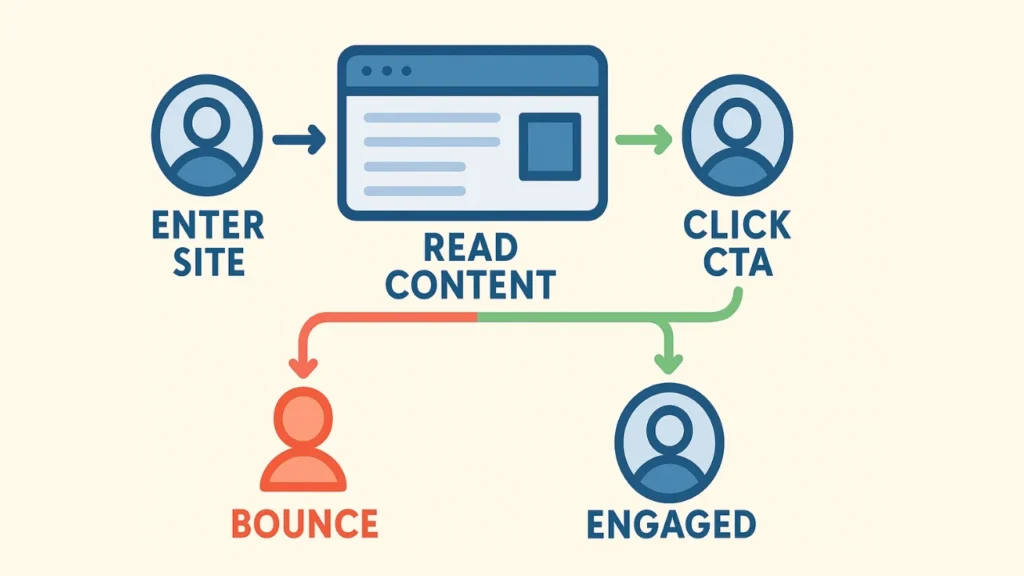
Advanced Bounce Rate Optimization Strategies
1- Behavioral Trigger Implementation
Advanced bounce rate optimization strategies leverage user behavior data to deliver personalized experiences:
Exit-Intent Technology: Detecting when users prepare to leave allows for last-moment engagement attempts through targeted offers or content suggestions.
Scroll-Based Triggers: Activating CTAs or content recommendations based on scroll depth ensures relevant timing.
Time-Based Interventions: Offering assistance or additional resources after specific time periods on page.
Device-Specific Optimization: Tailoring experiences based on device type, screen size, and interaction capabilities.
2- Personalization and Dynamic Content
Content Personalization: Displaying relevant content based on traffic source, geographic location, or previous site behavior.
Dynamic CTA Testing: Automatically serving different call-to-action variations based on user characteristics or behavior patterns.
Segmented Messaging: Crafting specific messages for different user types, industries, or intent levels.
3- Conversion Path Optimization
Micro-Conversion Tracking: Identifying and optimizing smaller engagement actions that lead to major conversions.
Funnel Analysis: Understanding complete user journeys to identify and address drop-off points.
Cross-Page Optimization: Ensuring consistency and logical progression across multiple page visits.
Industry-Specific Bounce Rate Optimization Strategies
1- E-commerce Implementation
E-commerce sites require specialized bounce rate optimization strategies:
Product Information Completeness: Displaying comprehensive details, high-quality images, pricing, availability, and customer reviews above the fold.
Trust Signal Prominence: Security badges, return policies, and customer service information reduce purchase anxiety.
Comparison Tool Integration: Helping users evaluate options without leaving the site.
Inventory and Shipping Clarity: Clear communication about availability and delivery timelines.
2- SaaS and Technology Services
Software companies benefit from targeted bounce rate optimization strategies:
Demo and Trial Prominence: Making it easy for users to experience products without commitment.
Feature Benefit Translation: Converting technical specifications into user benefits and outcomes.
Competitive Differentiation: Clear positioning against alternatives and competitors.
Use Case Demonstration: Showing specific applications and success stories relevant to target audiences.
3- Content Publishing and Media
Publishers should implement specialized bounce rate optimization strategies:
Related Content Recommendations: Algorithmic or manual suggestions for additional reading.
Email Capture Integration: Strategic newsletter signups and content upgrade offers.
Social Sharing Facilitation: Easy sharing options that extend content reach.
Comment and Engagement Features: Fostering community interaction and return visits.
4- Local Service Businesses
Location-based businesses require unique bounce rate optimization strategies:
Contact Information Prominence: Phone numbers, addresses, and hours clearly displayed.
Local SEO Integration: Maps, directions, and location-specific content.
Service Area Clarity: Clear communication about geographic coverage and availability.
Appointment Scheduling: Easy booking systems for service-based businesses.
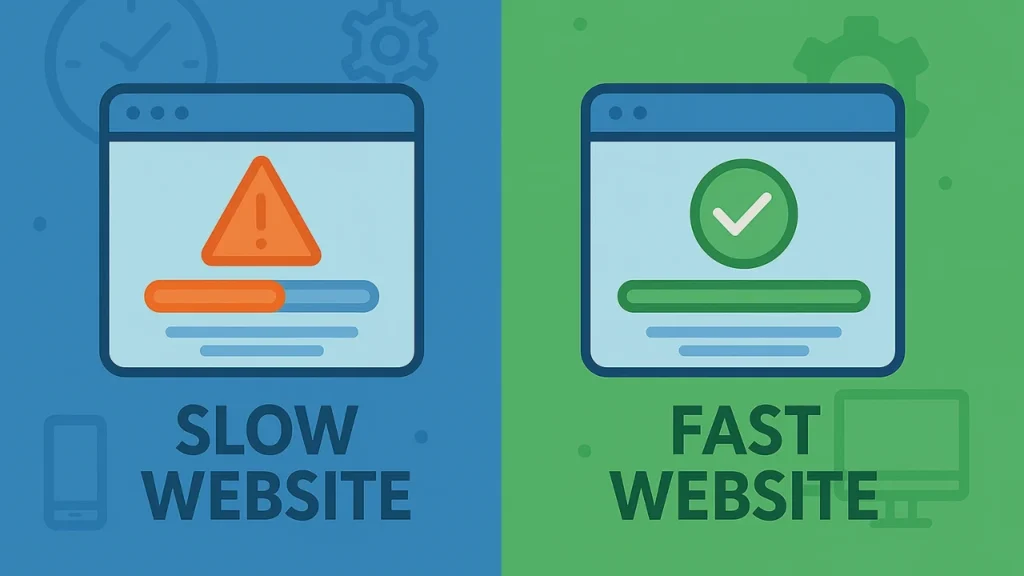
Measurement and Analytics for Bounce Rate Optimization Strategies
1- Google Analytics 4 Implementation
Custom Metric Creation: Adding bounce rate as a visible metric in standard reports.
Segmentation Analysis: Breaking down data by device type, traffic source, landing page, and user demographics.
Goal and Conversion Tracking: Understanding how bounce rate correlates with business objectives.
Audience Behavior Analysis: Identifying patterns in user engagement and site interaction.
2- Advanced Analytics Tools
Heatmap Analysis: Visualizing user behavior patterns, click distributions, and scroll depths using tools like Hotjar or Crazy Egg.
Session Recording Review: Watching actual user sessions to identify friction points and optimization opportunities.
User Feedback Collection: Exit-intent surveys and feedback tools provide direct insight into bounce reasons.
A/B Testing Platforms: Systematic testing of headlines, layouts, CTAs, and content variations for data-driven optimization.
3- Key Performance Indicators
Beyond bounce rate itself, monitoring related metrics provides comprehensive understanding:
Average Session Duration: Indicating content engagement quality and user interest levels.
Pages Per Session: Measuring site exploration depth and navigation effectiveness.
Conversion Rate Correlation: Understanding how bounce rate changes impact business outcomes.
Traffic Quality Assessment: Evaluating whether lower bounce rates translate to better lead quality and customer acquisition.
Common Bounce Rate Optimization Mistakes
1- Over-Optimization Pitfalls
Metric Obsession: Focusing solely on bounce rate numbers without considering user satisfaction or business objectives.
Universal Application: Applying the same optimization strategies across all page types without considering individual purposes.
Retention Desperation: Implementing aggressive pop-ups, auto-play media, or other intrusive tactics that damage user experience.
2- Technical Implementation Errors
Mobile Neglect: Optimizing desktop experiences while ignoring mobile performance issues.
Speed Sacrifice: Adding features or content that improve engagement but significantly slow page loading.
Testing Inconsistency: Making multiple changes simultaneously without isolating individual impact.
Creating a Sustainable Bounce Rate Optimization Strategy
1- Long-term Approach Development
Effective bounce rate optimization strategies require ongoing commitment rather than one-time fixes:
Regular Audit Scheduling: Monthly or quarterly reviews of high-traffic page performance.
Continuous Testing Culture: Systematic A/B testing of page elements, content, and user experience components.
User Feedback Integration: Regular collection and analysis of direct user feedback through surveys and usability testing.
Industry Trend Monitoring: Staying current with design trends, user behavior changes, and technology developments.
2- Resource Allocation and Prioritization
High-Impact Page Focus: Concentrating optimization efforts on pages with highest traffic and business impact.
Quick Win Identification: Implementing simple changes that provide immediate bounce rate improvements.
Long-term Project Planning: Developing comprehensive redesign or restructuring projects for sustained improvement.
Team Training and Development: Ensuring team members understand bounce rate optimization principles and implementation techniques.
Conclusion: Transforming Bounce Rate into Business Growth
Bounce rate serves as a powerful diagnostic tool when interpreted correctly and addressed strategically. The most effective bounce rate optimization strategies focus on understanding user intent, removing friction, and providing clear value propositions that encourage deeper engagement.
Rather than viewing bounce rate as a simple metric to minimize, successful marketers treat it as insight into user experience quality and content relevance. By implementing comprehensive bounce rate optimization strategies that address technical performance, content alignment, user experience design, and conversion path effectiveness, websites can transform casual visitors into engaged users and valuable customers.
The key to sustainable bounce rate improvement lies in continuous testing, user feedback integration, and commitment to providing genuine value at every touchpoint. When bounce rate optimization strategies align with user needs and business objectives, they create lasting improvements in website performance, user satisfaction, and revenue generation.
Remember that bounce rate optimization is not about manipulating users to stay longer—it’s about creating experiences so valuable and relevant that users naturally want to explore further. Focus on solving real user problems, providing clear navigation paths, and maintaining technical excellence, and bounce rate improvements will follow naturally.
Start implementing these bounce rate optimization strategies systematically, measure results consistently, and iterate based on data-driven insights. Your website’s performance, user satisfaction, and business outcomes will improve significantly as you master the art and science of bounce rate optimization.
Frequently Asked Question (FAQ) – Bounce Rate Optimization Strategies
1. What is bounce rate?
Bounce rate measures the percentage of visitors who land on a single page and leave without taking any action or viewing other pages. In Google Analytics 4, it’s redefined as unengaged sessions lasting under 10 seconds with no conversions. This metric is essential for effective bounce rate optimization strategies.
2. What is considered a good bounce rate?
Generally, 26-40% is excellent, 40-70% is average, and 70%+ indicates problems requiring bounce rate optimization. Most websites should target 40-60% for optimal performance. Rates below 20% may indicate tracking errors, so use Google Analytics benchmarking for accurate industry comparisons.
3. Why do visitors bounce from websites?
Common causes include slow loading times (users expect 2-4 seconds), irrelevant content that doesn’t match search intent, and poor mobile experience. Technical issues, misleading titles, cluttered layouts, and missing clear calls-to-action also drive bounces. Identifying these issues is crucial for successful bounce rate optimization.
4. Is a high bounce rate always bad?
No, context matters significantly in bounce rate optimization analysis. High bounce rates are acceptable when users find exactly what they need (contact info, blog answers) or on single-purpose landing pages. However, they indicate problems when caused by poor UX, irrelevant content, or technical issues preventing engagement.
5. How can I reduce my website’s bounce rate?
Focus on speed optimization (images, CDN, caching), mobile responsiveness, and matching content to search intent for effective bounce rate optimization. Improve readability with headers and bullet points, add compelling CTAs above the fold, and minimize distractions from ads or pop-ups. A/B test changes and track results over 2-4 weeks for best outcomes.

